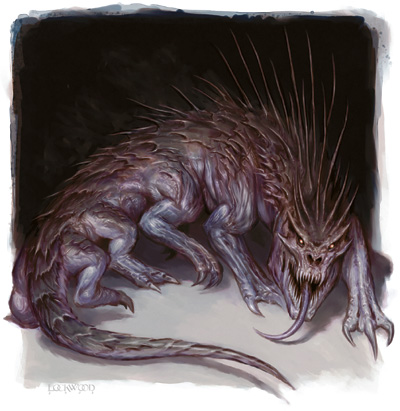

FREQUENCY: Very rare ([Temperate Wilderness
Hills], [Temperate Wilderness Forest], [Temperate Wilderness Swamp])
FREQUENCY: Very
rare ([Tropical Wilderness Hills], [Tropical Wilderness Forest],
[Tropical Wilderness Swamp])
FREQUENCY: Very rare ([Dungeon Level VII])
FREQUENCY:
Rare ([Astral Plane]) (* These creatures do not travel the astral or ethereal
planes but have attack forms that can affect travelers in these planes.)
FREQUENCY:
Very rare ([Ethereal Plane]) (* These
creatures do not travel the astral or ethereal planes but have attack forms
that can affect travelers in these planes.)
NO. APPEARING: 1-2
ARMOR CLASS: 2
MOVE: 6"
HIT DICE: 10
% IN LAIR: 50%
TREASURE TYPE: [H]
NO. OF ATTACKS: 3 ~ 10
DAMAGE/ATTACK: 1-6/1-6/2-16
SPECIAL ATTACKS: [SB]
SPECIAL DEFENSES: Surprised only 1 in
8
MAGIC RESISTANCE: Standard
INTELLIGENCE: Low
ALIGNMENT: Neutral (evil)
SIZE: L (12' long)
LEVEL/X.P. VALUE: VII | 3000 + 14
SAVES: 8.9.10.9.11
The greater basilisk is a cousin of the
more common reptilian horror, then ordinary basilisk.
Both have 8 legs and MOVE slowly.
Because of its
fearsome abilities, a greater basilisk
is typically used as a guardian of
treasure.
The monster can attack by raising its forebody, striking with its
sharp claws, and biting with its toothy
maw. The claws bear a weak
poison (saving throws made at +4). Its
foul breath is also poisonous, and
all creatures within 5 feet of its mouth
must save vs. poison (at +2) or die
whenever they spend even a moment so exposed.
(Checkeach round of
exposure). Worst of all, the greater basilisk
also has a gaze which turns
its victims to stone. Even if a polished
reflector is used under good light
conditions, the chance for a greater basilisk
to see its own gaze and be
petrified is only 10% unless the reflector
is within 10 feet of the creature.
While its gaze weapon is effective to
50 feet, the creature's oddlyshaped
eyes are nearsighted and it cannot see
its own gaze unless it is
within 10 feet.
The greater basilisk sees into the Astral
and Ethereal Planes, just as its
smaller cousin does. The normal habitat
of the greater basilisk has been
said to be the Elemental Plane of Earth.
Coloration of the greater basilisk
is much the same as that of other basilisks.